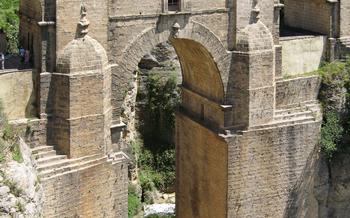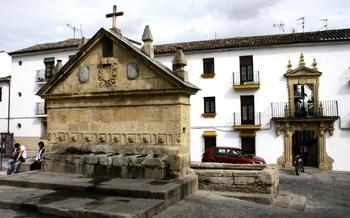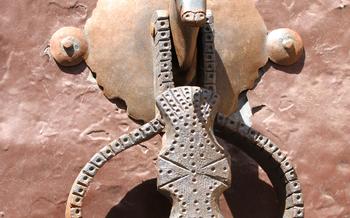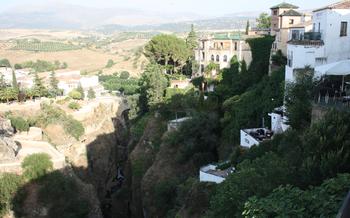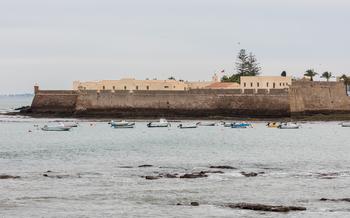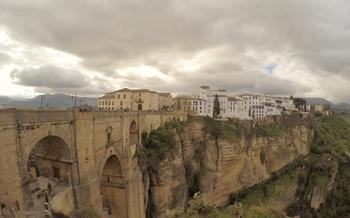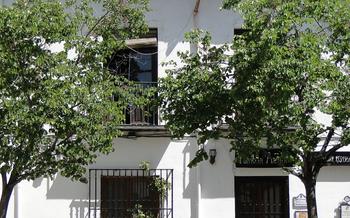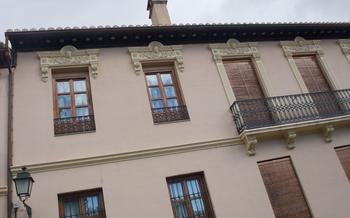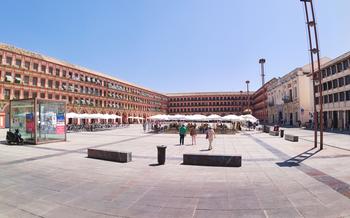
Baños Árabes (Ronda)
- The Baths of Ronda: A Legacy of Islamic Architecture
- Location and Access: Unveiling the City's Moorish Heritage
- A Glimpse into the Past: Exploring the Baths' History
- Architectural Elements: Unveiling the Baths' Splendor
- A Living Museum: Experiencing the Baths Today
- Exploring the Baths' Unique Features
- Immerse in History: A Journey Through Time
- Beyond the Baths: Discovering Ronda's Treasures
- A Culinary Adventure: Savoring Local Delights
- Capturing the Essence: Photography Opportunities
- Souvenirs and Mementos: Preserving Memories
- Practical Tips for a Smooth Visit
- Unveiling Hidden Gems: Exploring the Surroundings
- Insider Tip: Discovering the Baths' Secrets
The Baths of Ronda: A Legacy of Islamic Architecture
The Baños Árabes, or Arab Baths, stand as a testament to the rich Islamic heritage of Ronda, Spain. Constructed in the 13th century during the Nasrid dynasty's reign, these baths were integral to the city's social and cultural landscape. Built using traditional Islamic architectural techniques, they showcase intricate craftsmanship, domed ceilings, and stunning arches. The baths served as a crucial gathering place for locals to socialize, cleanse, and unwind, reflecting the vibrant cultural exchange and coexistence that characterized medieval Ronda. Their historical significance and architectural beauty render them a must-visit destination, offering a glimpse into a bygone era.
Location and Access: Unveiling the City's Moorish Heritage
The Baños Árabes are conveniently located in the heart of Ronda's historic city center, a short walk from the Plaza Duquesa de Parcent. To truly immerse yourself in the city's Moorish heritage, consider exploring the surrounding streets, lined with traditional whitewashed houses and adorned with colorful flower pots. The picturesque surroundings will transport you back in time as you approach the baths, adding to the overall charm of your visit.
Reaching the Baños Árabes is a breeze, whether you prefer to explore on foot or utilize public transportation. If you choose to walk, the journey will take you through Ronda's enchanting streets, allowing you to soak in the city's unique atmosphere. Alternatively, several bus lines stop within easy walking distance of the baths, making them accessible to visitors from all corners of the city.
The neighborhood surrounding the Baños Árabes is a vibrant tapestry of history, culture, and local life. Take some time to wander through the narrow cobbled streets, discover hidden plazas, and interact with friendly locals. You'll find an array of shops, cafes, and restaurants, providing ample opportunities to savor the flavors of traditional Andalusian cuisine and purchase unique souvenirs to cherish your visit.
A Glimpse into the Past: Exploring the Baths' History
The Baños Árabes, deeply rooted in history, date back to the 13th century, during the reign of the Nasrid dynasty. Their construction marked a significant chapter in Ronda's Islamic past, serving as a crucial part of the city's infrastructure. These baths were not merely places of ablution but also centers of social interaction and relaxation. Over time, they underwent several modifications and renovations, adapting to the changing needs of the city. In the 16th century, after the Christian reconquest, the baths were converted into a tannery and later used as a stable. It wasn't until the 20th century that their historical value was recognized, leading to their restoration and transformation into a cultural heritage site. Today, the Baños Árabes stand as a testament to Ronda's rich past, inviting visitors to delve into the city's Islamic legacy.
Architectural Elements: Unveiling the Baths' Splendor
The Baños Árabes of Ronda are a testament to the architectural prowess of the Islamic world. The baths are laid out in a symmetrical plan, with three main sections: the hot room, the warm room, and the cold room. Each section is adorned with intricate architectural elements that reflect the Moorish style.
The domed ceilings of the baths are supported by slender columns, creating a sense of spaciousness and grandeur. Skylights in the domes allow natural light to flood the baths, casting a soft and ethereal glow on the interior.
The walls are adorned with intricate tilework and carved plasterwork, featuring geometric patterns, floral motifs, and Arabic inscriptions. Horseshoe arches, a hallmark of Islamic architecture, frame the doorways and windows, adding to the overall aesthetic appeal of the baths.
The central pool, located in the hot room, is a focal point of the baths. It is surrounded by a raised platform, allowing bathers to relax and soak in the warm water. The pool is adorned with intricate tilework and features several fountains, creating a soothing and tranquil atmosphere.
A Living Museum: Experiencing the Baths Today
Today, the Baños Árabes stand as a testament to the city's rich past, preserved as a historical monument that invites visitors to step back in time. Interactive exhibits and displays bring the baths' history to life, showcasing the rituals, customs, and architectural innovations that made them a vital part of medieval Ronda. Guided tours led by knowledgeable historians provide an immersive experience, delving into the significance of the baths and their role in shaping the city's cultural heritage. To ensure accessibility for all, the site is equipped with ramps and elevators, allowing visitors with disabilities to fully explore the baths and its surroundings.
Exploring the Baths' Unique Features
The Baños Árabes stand out for their distinctive architectural elements, showcasing the intricate craftsmanship of Islamic builders. Geometric patterns, a hallmark of Islamic art, adorn the walls, ceilings, and arches, creating a mesmerizing visual tapestry. Horseshoe arches, a signature feature of Moorish architecture, lend an air of elegance and grandeur to the baths. The intricate tilework, with its vibrant colors and geometric designs, further enhances the aesthetic appeal of the building.
At the heart of the baths lies the central pool, a symbol of purification and relaxation. The pool's octagonal shape, an auspicious number in Islamic culture, represents balance and harmony. Its crystal-clear water, once heated by an ingenious underground system, invited bathers to immerse themselves in its soothing warmth.
The baths' natural light and ventilation systems are a testament to the builders' ingenuity. Skylights, strategically positioned in the domed ceilings, allowed sunlight to flood the interior, creating a bright and airy atmosphere. Combined with carefully designed ventilation shafts, these features ensured a comfortable and pleasant bathing experience.
Immerse in History: A Journey Through Time
The Baños Árabes of Ronda offer a unique opportunity to immerse yourself in the history and culture of medieval Spain. Guided tours bring the past to life, with guides sharing fascinating anecdotes and stories related to the baths' construction, use, and significance. Historical reenactments and immersive experiences transport visitors back in time, allowing them to experience the baths as they were centuries ago. Multimedia displays provide a deeper understanding of the baths' architectural features, bathing rituals, and cultural context. Hands-on activities and interactive learning stations encourage visitors to engage with the history and traditions of the baths, creating a truly memorable and educational experience.
Beyond the Baths: Discovering Ronda's Treasures
A visit to the Baños Árabes is not just a journey into the past but also a gateway to exploring the rich cultural heritage of Ronda. Beyond the baths, the city offers a treasure trove of attractions that will captivate history buffs, art enthusiasts, and nature lovers alike.
Stroll across the iconic Puente Nuevo, a magnificent bridge spanning the El Tajo gorge, and marvel at the breathtaking views of the surrounding countryside. Immerse yourself in the vibrant atmosphere of the Plaza de Toros, one of Spain's oldest bullrings, and learn about the city's deep-rooted bullfighting traditions.
Delve into the city's history at the Museo de Ronda, which houses a fascinating collection of artifacts and exhibits showcasing Ronda's past from prehistoric times to the present day. Discover the stories of Ronda's famous bandits and explore the intricate network of underground tunnels and caves that lie beneath the city.
Ronda's charm extends beyond its historical landmarks. Take a leisurely walk through the narrow cobbled streets of the old town, admiring the whitewashed houses adorned with colorful flowers. Indulge in the local gastronomy at traditional restaurants, savoring the flavors of Andalusian cuisine while enjoying panoramic views of the surrounding landscape.
Whether you're seeking historical wonders, cultural experiences, or simply breathtaking scenery, Ronda offers an abundance of treasures waiting to be discovered. Let the city's rich heritage and natural beauty captivate you as you create lasting memories in this enchanting destination.
A Culinary Adventure: Savoring Local Delights
Ronda's culinary scene is as enticing as its historical treasures. To truly immerse yourself in the local culture, venture beyond the typical tourist traps and explore the city's hidden culinary gems. Start your culinary journey at Bar El Lechuguita, a beloved institution among locals, renowned for its mouthwatering tapas and traditional Andalusian dishes. Savor the flavors of "migas," a hearty dish made with toasted breadcrumbs, and "sopas perotas," a flavorful bread soup with vegetables and poached eggs.
For a panoramic dining experience, head to Restaurante Mirador de Ronda, perched on a hilltop overlooking the city's stunning skyline. Indulge in regional specialties while enjoying breathtaking views of the surrounding mountains. Don't miss the opportunity to visit the Mercado Municipal de Ronda, a vibrant market showcasing the region's freshest produce, artisanal cheeses, and cured meats. Here, you can shop for ingredients to create your own culinary masterpiece or simply soak in the lively atmosphere.
Uncover hidden culinary gems by venturing off the beaten path. Ask locals for recommendations or explore the narrow cobbled streets to discover charming tapas bars and family-run restaurants. Indulge in traditional dishes such as "callos a la rondeña," a rich and flavorful tripe stew, or "porra antequerana," a chilled tomato soup with tuna and egg. Remember to save room for dessert, as Ronda's confectionery tradition is equally tempting. Try the "yemas del Tajo," delicate egg yolk pastries, or the "bienmesabe," a sweet almond cream dessert. As you savor the local delicacies, you'll create lasting memories of Ronda's vibrant culinary culture.
Capturing the Essence: Photography Opportunities
The Baños Árabes are a photographer's paradise, offering a wealth of opportunities to capture stunning images. The intricate architecture, with its geometric patterns, horseshoe arches, and delicate tilework, provides a feast for the eyes. The central pool, with its crystal-clear water, adds a touch of serenity to the scene.
To make the most of your photography experience, it's important to choose the right time of day. The early morning or late afternoon light is ideal, as it casts long shadows that accentuate the baths' architectural features. Using a tripod can help you stabilize your camera and capture sharp images, especially in low-light conditions.
Experiment with different angles and perspectives to create unique and captivating shots. Try shooting from above, below, or from a distance to capture the baths' grandeur. Don't be afraid to get close to the details, such as the intricate tilework or the worn steps, to add depth and texture to your images.
The baths' natural light and ventilation systems offer additional photographic opportunities. The skylights, with their intricate geometric designs, create beautiful patterns of light and shadow on the walls and floors. The ventilation shafts, with their unique shapes and angles, can add a touch of mystery and intrigue to your shots.
Whether you're a professional photographer or simply an enthusiast, the Baños Árabes are a must-visit destination for capturing stunning and memorable images.
Souvenirs and Mementos: Preserving Memories
As you bid farewell to the captivating Baños Árabes, consider preserving your memories by purchasing unique souvenirs and handicrafts. Explore local shops and markets, where artisans create exquisite pieces that reflect the spirit of Ronda. Discover intricately patterned ceramics, handwoven textiles, and locally crafted jewelry, each piece imbued with the essence of Andalusian artistry. Look for authentic souvenirs that showcase the region's rich cultural heritage, from traditional pottery and leather goods to hand-painted tiles and decorative items. Remember to pack your souvenirs carefully, ensuring that these cherished mementos of your journey through time remain intact and vibrant, ready to evoke the magic of Ronda whenever you behold them.
Practical Tips for a Smooth Visit
To make the most of your visit to the Baños Árabes, here are some practical tips to ensure a smooth and enjoyable experience:
Plan Your Visit for Fewer Crowds: To avoid the hustle and bustle, aim to visit the baths during non-peak hours. Early mornings or late afternoons are ideal times for a more tranquil experience.
Dress Code: While there is no strict dress code, it's recommended to dress respectfully, especially when visiting during prayer times. Avoid wearing revealing or overly casual clothing.
Accessibility: The baths are generally accessible to visitors with physical limitations. However, it's advisable to inquire about any specific needs or accessibility concerns in advance.
Pet-Friendly Policies: Unfortunately, pets are not allowed inside the baths due to hygiene and safety regulations.
Unveiling Hidden Gems: Exploring the Surroundings
Beyond the captivating charm of Ronda, the surrounding region unveils a tapestry of hidden gems waiting to be discovered. Embark on a day trip to nearby towns and villages, each with its unique character and allure. Explore the Serrania de Ronda, a natural paradise boasting breathtaking views, rugged landscapes, and an abundance of flora and fauna. Discover hidden hiking trails that wind through picturesque valleys, leading to secluded viewpoints offering panoramic vistas of the region. Embrace the spirit of adventure with outdoor activities such as rock climbing, mountain biking, and horseback riding, immersing yourself in the unspoiled beauty of the Andalusian countryside.
Insider Tip: Discovering the Baths' Secrets
Beyond their architectural beauty, the Baños Árabes hold a wealth of hidden secrets and intriguing stories. One fascinating aspect is the source of the baths' water, which is believed to originate from a nearby spring known as the "Fuente de los Ocho Caños" (Fountain of the Eight Spouts). According to local legend, the water possesses healing properties and was once used for medicinal purposes.
Another captivating tale is the story of the "baño de la reina" (Queen's bath), a private section of the baths reserved for the exclusive use of the city's queen. This secluded chamber, adorned with intricate tilework and delicate carvings, was a place of relaxation and rejuvenation for the royal family.
Moreover, the baths have been the subject of numerous local legends and myths. One popular tale speaks of a hidden treasure buried beneath the baths, guarded by a mysterious spirit. Another story tells of a beautiful princess who was said to have bathed in the waters of the baths, leaving behind her enchanting presence.
To fully immerse yourself in the history and mystique of the Baños Árabes, be sure to ask your guide about these hidden gems and local traditions. They will provide you with a deeper understanding of the baths' cultural significance and the rich tapestry of stories that surround them.
